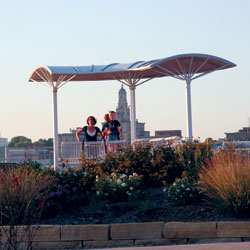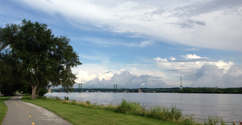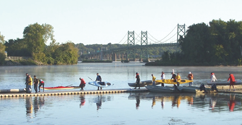Which flood prompted Rock Island to build its levee?

CLICK HERE to learn which flood prompted Rock Island to build its levee.
The area inland from this observation point was once consumed by railroading.
Row upon row of rail lines extended from here eastward to the Arsenal Viaduct. Several depots were in the immediate vicinity, plus freight stations more than a block long.
The last of the large stations was the Chicago, Burlington & Quincy Depot, with its 6-story clock tower, which was destroyed by fire in 1968.
Of the numerous railroads that have served Rock Island, probably most well known was the Chicago, Rock Island & Pacific Railroad. It was originally the Chicago and Rock Island Railroad, the first to reach the Mississippi river from the east in 1854 and the first to bridge the river in 1856.
The Rock Island Lines grew to include thousands of miles of track from to Illinois to Texas, New Mexico, Colorado, and Minnesota. Its streamlined Rockets were familiar sights across this territory during the mid twentieth century.
But the great railroad’s end was near in 1964, when the Rock Island Lines selected the Union Pacific as a potential merger partner. In the process, the Rock Island became the victim of the most complicated merger in the history of the Interstate Commerce Commission. Court cases and fees followed, and track maintenance suffered. Eventually, the Union Pacific backed out of the merger and the rail line was sold off in pieces. Today the Burlington Northern Santa Fe Railroad and Iowa Interstate Railroad share the track you see here.
The levee you are standing on was built to provide flood protection. Prior to 1970, the nearby rail lines and the entire downtown area routinely suffered from floods. Terrible floods were recorded in 1828, 1851 and 1951, with water flowing five blocks inland, and hundreds of citizens and businesses displaced. But the flood to end all floods took place in 1965, when the crest reached 22.48 feet, 7-1/2 feet above flood stage, and stayed above flood stage for nearly three weeks.
Saviors of the flood came in the form of the youth of the community, as classes were suspended for local high school and college students so they could fill and place sandbags, protecting Rock Island businesses and homes. The Flood of 1965 forced a decision upon Quad Cities leaders: to build a flood wall against future floods and intrude on access to the river, or invite damage from future floods but keep the view to the waterway open. Rock Island chose to build the flood wall, and so the levee project began in 1970.
One of the best places to watch for bald eagles is right here at the 20th Street Overlook, which was enhanced through a partnership of River Action, the City of Rock Island, and Scenic Byways in 2006. Illinois is home to the largest population of wintering eagles in the continental United States. Eagles flock to open rivers in the middle of winter to feed, and this protected slough on the Mississippi River is a popular spot. You can read more about migrating eagles on the RiverWay podium here at the overlook.









